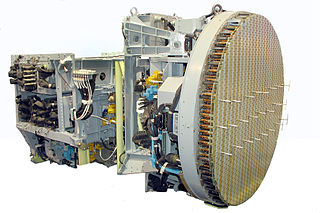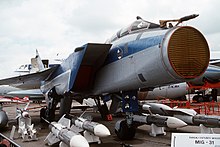
Radar is a radiolocation system that uses radio waves to determine the distance (ranging), angle (azimuth), and radial velocity of objects relative to the site. It is used to detect and track aircraft, ships, spacecraft, guided missiles, motor vehicles, map weather formations, and terrain. A radar system consists of a transmitter producing electromagnetic waves in the radio or microwaves domain, a transmitting antenna, a receiving antenna and a receiver and processor to determine properties of the objects. Radio waves from the transmitter reflect off the objects and return to the receiver, giving information about the objects' locations and speeds.

In antenna theory, a phased array usually means an electronically scanned array, a computer-controlled array of antennas which creates a beam of radio waves that can be electronically steered to point in different directions without moving the antennas. The general theory of an electromagnetic phased array also finds applications in ultrasonic and medical imaging application and in optics optical phased array.

An active electronically scanned array (AESA) is a type of phased array antenna, which is a computer-controlled antenna array in which the beam of radio waves can be electronically steered to point in different directions without moving the antenna. In the AESA, each antenna element is connected to a small solid-state transmit/receive module (TRM) under the control of a computer, which performs the functions of a transmitter and/or receiver for the antenna. This contrasts with a passive electronically scanned array (PESA), in which all the antenna elements are connected to a single transmitter and/or receiver through phase shifters under the control of the computer. AESA's main use is in radar, and these are known as active phased array radar (APAR).

A pulse-Doppler radar is a radar system that determines the range to a target using pulse-timing techniques, and uses the Doppler effect of the returned signal to determine the target object's velocity. It combines the features of pulse radars and continuous-wave radars, which were formerly separate due to the complexity of the electronics.
A low-probability-of-intercept radar (LPIR) is a radar employing measures to avoid detection by passive radar detection equipment while it is searching for a target or engaged in target tracking. This characteristic is desirable in a radar because it allows finding and tracking an opponent without alerting them to the radar's presence. This also protects the radar installation from anti-radiation missiles (ARMs).

A counter-battery radar or weapon tracking radar is a radar system that detects artillery projectiles fired by one or more guns, howitzers, mortars or rocket launchers and, from their trajectories, locates the position on the ground of the weapon that fired it. Such radars are a subclass of the wider class of target acquisition radars.

The AN/MPQ-64 Sentinel is an X-band electronically steered pulse-Doppler 3D radar system used to alert and cue Short Range Air Defense (SHORAD) weapons to the locations of hostile targets approaching their front line forces. It is currently produced by Raytheon Missiles & Defense.

The AN/APQ-181 is an all-weather, low probability of intercept (LPI) phased array radar system designed by Hughes Aircraft for the U.S. Air Force B-2A Spirit bomber aircraft. The system was developed in the mid-1980s and entered service in 1993. The APQ-181 provides a number of precision targeting modes, and also supports terrain-following radar and terrain avoidance. The radar operates in the Ku band. The original design uses a TWT-based transmitter with a 2-dimensional passive electronically scanned array (PESA) antenna.
The AN/APG-76 radar is a pulse Doppler Ku band multi-mode radar developed and manufactured by Northrop Grumman.
Phased-array optics is the technology of controlling the phase and amplitude of light waves transmitting, reflecting, or captured (received) by a two-dimensional surface using adjustable surface elements. An optical phased array (OPA) is the optical analog of a radio-wave phased array. By dynamically controlling the optical properties of a surface on a microscopic scale, it is possible to steer the direction of light beams, or the view direction of sensors, without any moving parts. Phased-array beam steering is used for optical switching and multiplexing in optoelectronic devices and for aiming laser beams on a macroscopic scale.
Radar engineering details are technical details pertaining to the components of a radar and their ability to detect the return energy from moving scatterers — determining an object's position or obstruction in the environment. This includes field of view in terms of solid angle and maximum unambiguous range and velocity, as well as angular, range and velocity resolution. Radar sensors are classified by application, architecture, radar mode, platform, and propagation window.

The Zhuk are a family of Russian all-weather multimode airborne radars developed by NIIR Phazotron for multi-role combat aircraft such as the MiG-29 and the Su-27. The PESA versions were also known as the Sokol.

The Bars (Leopard) is a family of Russian all-weather multimode airborne radars developed by the Tikhomirov Scientific Research Institute of Instrument Design for multi-role combat aircraft such as the Su-27, Su-30 and the MiG-29.

A phase shift module is a microwave network module which provides a controllable phase shift of the RF signal. Phase shifters are used in phased arrays.
Frequency agility is the ability of a radar system to quickly shift its operating frequency to account for atmospheric effects, jamming, mutual interference with friendly sources, or to make it more difficult to locate the radar broadcaster through radio direction finding. The term can also be applied to other fields, including lasers or traditional radio transceivers using frequency-division multiplexing, but it remains most closely associated with the radar field and these other roles generally use the more generic term "frequency hopping".

An antenna array is a set of multiple connected antennas which work together as a single antenna, to transmit or receive radio waves. The individual antennas are usually connected to a single receiver or transmitter by feedlines that feed the power to the elements in a specific phase relationship. The radio waves radiated by each individual antenna combine and superpose, adding together to enhance the power radiated in desired directions, and cancelling to reduce the power radiated in other directions. Similarly, when used for receiving, the separate radio frequency currents from the individual antennas combine in the receiver with the correct phase relationship to enhance signals received from the desired directions and cancel signals from undesired directions. More sophisticated array antennas may have multiple transmitter or receiver modules, each connected to a separate antenna element or group of elements.

The Radar Set AN/MPQ-4 was a US Army counter-battery radar primarily used to find the location of enemy mortars and larger artillery in a secondary role. Built by General Electric, it first entered service in 1958, replacing the earlier and much simpler AN/MPQ-10. The MPQ-4 could determine the location of an enemy mortar in as little as 20 seconds by observing a single round, whereas the MPQ-10 required several rounds to be launched and could take 4 to 5 minutes to take a "fix". The MPQ-4 remained one of the primary US counter-battery systems through the late 1970s until it was replaced by passive electronically scanned array radars like the AN/TPQ-36.
The AR-3D was a military air traffic control and early warning radar developed by Plessey and first produced in 1975. It used a pencil beam and simple frequency scanning system known as "squint scan" to produce a low-cost 3D radar system that was also relatively mobile. About 23 were produced in total and found sales around the world into the early 1980s.
The AR-320 is a 3D early warning radar developed by the UK's Plessey in partnership with US-based ITT-Gilfillan. The system combined the receiver electronics, computer systems and displays of the earlier Plessey AR-3D with a Gilfillan-developed transmitter and planar array antenna from their S320 series. The main advantage over the AR-3D was the ability to shift frequencies to provide a level of frequency agility and thus improve its resistance to jamming.












